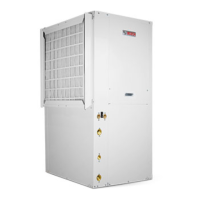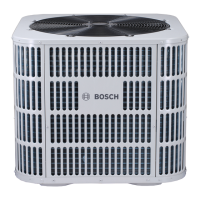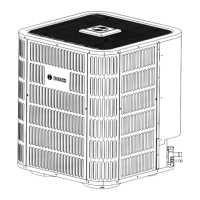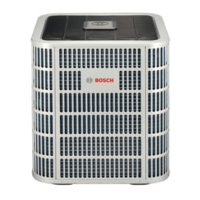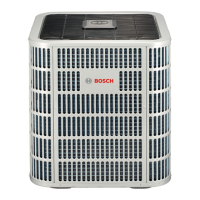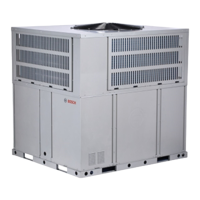6 720 220 045
Revised 01-11 Subject to change without prior notice
contactor are energized through the contacts of the
reheat relay. See Typical Wiring Diagram page 28.
The cooling relay remains de-energized enabling the
reheat solenoid (Note: The reheat mode always
operates in the cooling mode.) Should the
temperature in the space increase above set point
the compressor terminal Y is energized which will
de-energize the reheat valve putting the unit into the
straight cooling mode. A call for cooling or heating
will always take precedence over hot gas reheat.
Hot Gas Reheat Controllers
There are several ways to control heat pumps with
hot gas reheat. You should choose the means that
best suits your specic application. The Typical
Wiring Diagram on page 28 illustrates one possible
control sequence. Most heat pump compatible
thermostats in conjunction with a humidistat are
acceptable for use, (Note: “O” output for reversing
valve energized in cooling mode is required.)
Combination thermostats/humidistat are also
available.
Special Considerations
Some applications require special consideration
to maximize the performance of the hot gas reheat
function:
• Low Temperature Well Water
• Indoor Pool Dehumidifying During Winter Months
Consult the factory for special application
considerations.
Low Temperature Well Water
When low temperature well water is utilized as the
water source (below 55°F), a means of establishing
two ow rates, one for the cooling/reheat mode and
one for heating mode is recommended. In the
cooling mode at low entering water temperatures
and standard ow rates discharge pressures and
corresponding discharge gas temperatures are
relatively low. At these conditions when the reheat
mode is initiated the low temperature discharge gas
can reduce reheat capacity. A means to reduce the
water ow rate and elevate the discharge pressure/
temperature in cooling/reheat mode should be
provided. Conversely, at low entering water
temperatures in the heating mode system suction
pressure is reduced causing a loss in heating capacity.
A means of providing higher ow in the heating mode
should be provided. The simplest way to accomplish
the above is to install water regulating valves.
Indoor Pool Dehumidifying During
Winter Months
It is important to remember that when in the reheat
mode the heat pump is cooling and reheating. A
secondary means of heating the space during the
dehumidication mode should be provided. The
indoor space temperature should be kept at least
2°F above the pool water temperature. If this is not
done the warm pool water attempts to heat the
space and the humidity levels increase
exponentially. The heat pump is normally sized to
handle the design latent load moisture removal. A
second heat pump or resistance heat should be
provided to handle the structural loss load.
A protective coating is highly recommended for all
pool applications due to the highly corrosive
chemical environment.
FLUID DIFFERENTIAL PRESSURE
SWITCH (DPS)
The function of the differential switch is to prevent
or stop compressor operation should the water
supply fail. This will prevent the unit from locking
out on a safety requiring manual reset to restart.
The switch is piped between the water entering and
leaving connections. Should the pressure drop fall
below set value the switch will open de-energizing
the DPS relay thereby stopping the compressor.
The controller has an adjustment to change the
minimum pressure differential required to open the
switch and may require eld adjustment.
The blower operation will not be affected by this
option.
The start-up process should include checking the
operation of the switch when installed. This
should be done after the system is balanced.
Adjustment should be made if necessary.
Sequence of Operation CP/BP Series 11
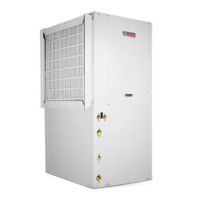
